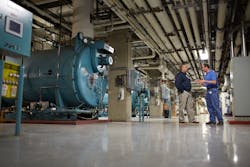One Contractor’s Success Using Construction-Specific Software
By Terri Gresham
As one of the Pacific Northwest’s leading full-service, design-build mechanical contractors, energy consultants and servicers, UMC has played a key role in some of the region’s most iconic and complex projects—from the original build of the Seattle Space Needle in the 1960s to the Amazon Spheres, which are three dome-like glass structures at the online retail giant’s downtown Seattle campus.
However, as UMC has continued to expand its services in recent years, growing pains started to become more evident, particularly the collaboration and data gaps between accounting, HR and project management. “There was a lack of connection between these systems and a lot of manual processes and double entry happening, which took valuable staff time,” said Chris Betlach, UMC’s IT Director.
According to Betlach, the collaboration and data gaps were the result of multiple third-party software systems that couldn’t easily share data with one another or with UMC’s existing ERP platform. The company also had limited digital recruiting, onboarding and other HR capabilities, which was slowing their workforce pipeline.
“It was time to move to the cloud,” Betlach said. “We realized that lack of data interconnectivity was keeping us back, plus we knew the cloud would allow us to use new functionalities, simplify administration of our systems and improve server uptime, security and accessibility of our data.”
From On-Prem to the Cloud
While UMC had utilized Trimble Viewpoint’s Vista ERP platform since 1998, all of the data was located on-premise, which was a lot for the IT department to manage. “Having all of our data on-prem meant that we had to do all the updates, security and backups in-house,” Betlach said. “If you’re short staffed, which most companies are given the difficult finding and retaining talent, it can be a lot to keep up with.”
UMC made the leap to the cloud by upgrading to Trimble Construction One, which brought forth a host of new benefits, the biggest of which was replacing multiple third-party vendors with a single suite of construction-specific business applications that share data and workflows. Since moving to the cloud, UMC has seen improvements in many areas, particularly in security, human resources and payroll automation.
“At UMC, we have a multi-layered security approach, and we follow security best practices to harden our systems,” Betlach said. “Since moving to the cloud, it’s been great to have an external support team manage patches and updates, while also consistently monitoring the system for abnormal behavior or potential security threats.”
Empowering Employees
“Before moving to the cloud, our onboarding process was a manual pen-and-paper process, with employee information double-entered into multiple systems,” said Betlach. “Now employees can enter their own information, and it’s internally connected to other systems like payroll. This has cut our onboarding time by half because the paperwork is easier to complete and legible.”
Employees can now self-serve many of their own HR needs like viewing pay stubs, entering and tracking time, and updating personal information through easy-to-use online portals. This takes the burden off HR teams and puts the power into employees’ own hands.
Applicant tracking and onboarding features have also helped streamline data collection, making it easy to produce reports for executive teams and for EEOC compliance. UMC can now easily capture demographics, number of applicants and sourcing, and give immediate updates to their executive and HR teams.
Automating Payroll
Another benefit of the cloud has been the ability to track and record time digitally, with the added ability to “clone” timesheets week-to-week. This has been particularly helpful for office staff who work on the same jobs every week.
For the accounts payable (AP) and payroll (PR) teams who work on many jobs, UMC found that by using the previous week’s data, they were able to accurately calculate the time spent processing AP and PR to apply overhead time to those jobs. The calculated data is then auto-populated into those team’s timecards, saving them from having to manually input their time.
“This saves the accounting team several hours each week since they no longer have to guess how much time they’ve spent processing payroll for jobs or doing one invoice over another,” Betlach said. “It’s been a huge time-saver for us, and we’re looking to replicate it for our contract administration and purchasing teams too.”
Field staff have a slightly different, grid-type timesheet, which enables forepersons to enter time for multiple installers all from one screen. Once timesheets are approved, they’re entered directly into payroll instead of having to wait for third-party integrations. PTOs approvals are also digital, enabling them to be approved faster while also ensuring that there will be adequate coverage when people are out.
A Data-Focused Future
Since moving to the cloud, UMC has been able to consolidate multiple software systems into one, simplifying the administrative burden while also providing the company with a scalable technology platform that provides enhanced security, HR and payroll automation benefits.
“At the end of the day, we look at data as an asset that we want to use to automate tasks and make as many data-driven decisions as possible,” Betlach said. “Doing so allows us to be more efficient so that we can work on more value-added tasks and make decisions that are grounded in data versus guesswork, ensuring we’re making the right choices that will help guarantee UMC’s long-term future.”
Terri Gresham is the Manager of HR and ePayments Specialists at Trimble Viewpoint. She has 20 years of experience in HR Technology, which has led to her deeply held belief that technology must empower the employee and drive company growth.


